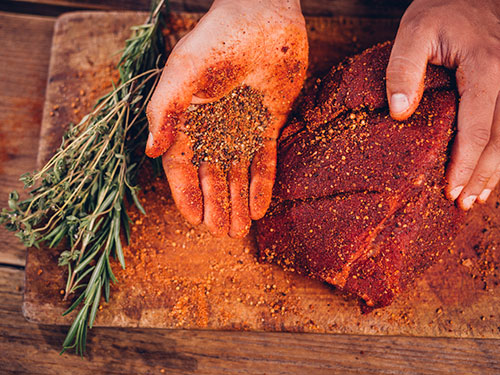Become a grill master with these simple tips
Fire + food = good. To make sure that equation never changes, here are a few meat and veggie barbecue tips from Professional Meat Cutting and Merchandising chair, Rob Povey (Retail Meatcutting '07).
(And don't miss the recipe for barbecued cilantro pest chicken below!)
How to choose meat
The most flavourful cuts of steak are sirloin and New York, but they aren’t always tender. The tenderest cuts of steak (and the most expensive) are rib-eye and tenderloin.
The best bang for your buck is to buy top sirloin, a good quality meat that tends to go on sale.
 Charcoal or gas?
Charcoal or gas?
Charcoal barbecuing will definitely give you better flavour than a gas barbecue, because it adds smokiness. Let the briquettes turn white before you put the meat on.
How to add smokiness
Other than cooking on charcoal briquettes, it’s also possible to add smokiness by placing assorted wood chips (which you can get at hardware and some department stores) in tin foil with a bit of water. The wood chips will absorb the water and the heat from the barbecue will cause the wood chips to smoulder, giving the meat a smoky flavour.
When to marinate
It’s better to select higher quality meats like top sirloin, New York steak or rib-eye, or beef tenderloin, than to marinate.
But, if you have a round steak, for example, you could marinate it the night before. First, needle the round steaks with a hand needler. Don’t use a fork – needling allows the marinade to penetrate the meat fibres. While barbecuing, baste the steak with the excess marinade. Barbecue on a lower heat and add wood chips for smoky flavor. Do not barbecue on high heat.
You can also marinate salmon and pork tenderloin the night before, but never for any longer. Overdo it and you’ll lose the natural flavour of the meat.
 How to season
How to season
Keep it simple. Rub your steak with olive oil and sprinkle a little Montreal steak spice on it. The olive oil will prevent the salt in the seasoning from drawing the moisture out of your steaks. The same method applies for chicken and pork, but use either Montreal chicken or pork spice.
How to sear meat
Sear one side then flip. Flip only once more, not multiple times. Also, use tongs to flip your meat; using a fork will introduce holes through which the juices can escape.
Degrees of “doneness”
The surest method to check if steak is done is to use an instant-read meat thermometer:
- Medium rare: cook to 62.8 C (145 F)
- Medium: cook to 71.1 C (160 F)
- Well-done: cook to 76.7 (170 F)
Because heat is difficult to control on the barbecue, it is easy to overcook, which is one of the biggest causes of tough steaks. Don’t put steaks on direct heat; move them to the side of the barbecue for better control and remove as soon as they’re cooked to your preference.
Cook chicken to 82.2 C (180 F) and insert the thermometer between the thigh and breast portion. Cook pork to 71.1 C (160 F).
After removing meat from the grill, allow it to sit for five minutes before cutting. This allows the juices to settle and keeps the meat tender and flavourful.
 Barbecuing vegetables
Barbecuing vegetables
Potatoes, peppers, eggplant, tomatoes, corn on the cob, button mushrooms and summer squash work best on the barbecue. Begin with vegetables that take the longest to cook. Denser vegetables such as potatoes or peppers will take longer than moisture-filled ones such as tomatoes.
If cooking directly on the grill, brush the vegetables lightly with oil so they don't stick. Turn them often, brushing on marinade as needed.
If you’re cooking them in a foil pouch add a bit of garlic butter and some seasoning and close up the pouch.
When using wooden skewers for shish kabob, soak skewers in water for 30 minutes before placing on the grill. This will keep the skewers from burning or smoking.
Remove the vegetables from heat when they can be easily pierced with a fork.